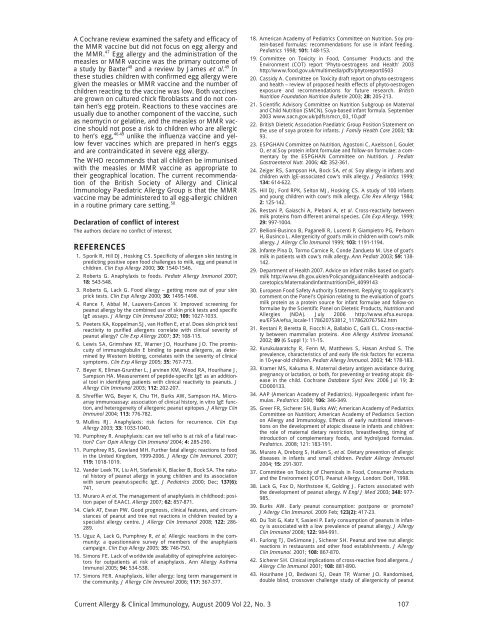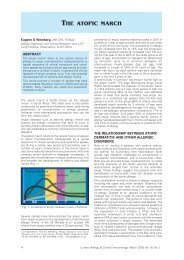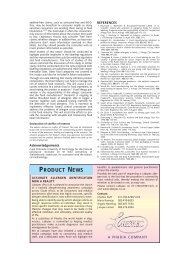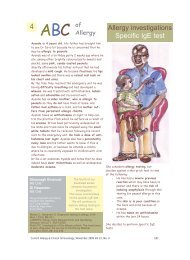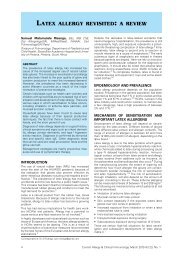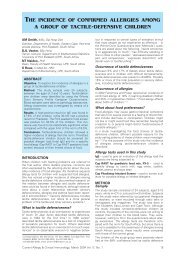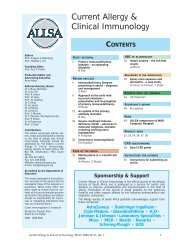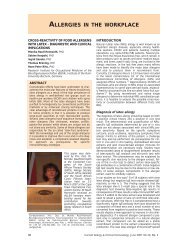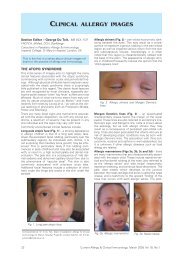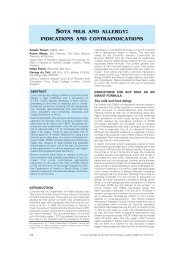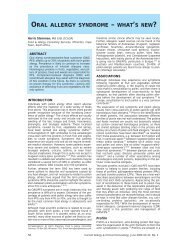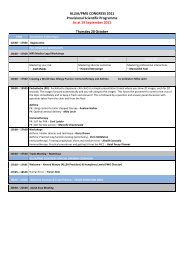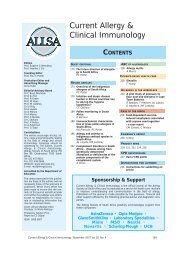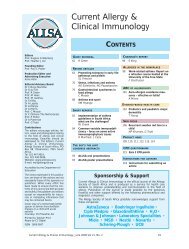Current Allergy & Clinical Immunology - ALLSA
Current Allergy & Clinical Immunology - ALLSA
Current Allergy & Clinical Immunology - ALLSA
You also want an ePaper? Increase the reach of your titles
YUMPU automatically turns print PDFs into web optimized ePapers that Google loves.
A Cochrane review examined the safety and efficacy of<br />
the MMR vaccine but did not focus on egg allergy and<br />
the MMR. 47 Egg allergy and the administration of the<br />
measles or MMR vaccine was the primary outcome of<br />
a study by Baxter 48 and a review by James et al. 49 In<br />
these studies children with confirmed egg allergy were<br />
given the measles or MMR vaccine and the number of<br />
children reacting to the vaccine was low. Both vaccines<br />
are grown on cultured chick fibroblasts and do not contain<br />
hen’s egg protein. Reactions to these vaccines are<br />
usually due to another component of the vaccine, such<br />
as neomycin or gelatine, and the measles or MMR vaccine<br />
should not pose a risk to children who are allergic<br />
to hen’s egg, 46-49 unlike the influenza vaccine and yellow<br />
fever vaccines which are prepared in hen’s eggs<br />
and are contraindicated in severe egg allergy.<br />
The WHO recommends that all children be immunised<br />
with the measles or MMR vaccine as appropriate to<br />
their geographical location. The current recommendation<br />
of the British Society of <strong>Allergy</strong> and <strong>Clinical</strong><br />
<strong>Immunology</strong> Paediatric <strong>Allergy</strong> Group is that the MMR<br />
vaccine may be administered to all egg-allergic children<br />
in a routine primary care setting. 50<br />
Declaration of conflict of interest<br />
The authors declare no conflict of interest.<br />
REFERENCES<br />
1. Sporik R, Hill DJ, Hosking CS. Specificity of allergen skin testing in<br />
predicting positive open food challenges to milk, egg and peanut in<br />
children. Clin Exp <strong>Allergy</strong> 2000; 30: 1540-1546.<br />
2. Roberts G. Anaphylaxis to foods. Pediatr <strong>Allergy</strong> Immunol 2007;<br />
18: 543-548.<br />
3. Roberts G, Lack G. Food allergy – getting more out of your skin<br />
prick tests. Clin Exp <strong>Allergy</strong> 2000; 30: 1495-1498.<br />
4. Rance F, Abbal M, Lauwers-Cances V. Improved screening for<br />
peanut allergy by the combined use of skin prick tests and specific<br />
IgE assays. J <strong>Allergy</strong> Clin Immunol 2002; 109: 1027-1033.<br />
5. Peeters KA, Koppelman SJ, van Hoffen E, et al. Does skin prick test<br />
reactivity to purified allergens correlate with clinical severity of<br />
peanut allergy Clin Exp <strong>Allergy</strong> 2007; 37: 108-115.<br />
6. Lewis SA, Grimshaw KE, Warner JO, Hourihane JO. The promiscuity<br />
of immunoglobulin E binding to peanut allergens, as determined<br />
by Western blotting, correlates with the severity of clinical<br />
symptoms. Clin Exp <strong>Allergy</strong> 2005; 35: 767-773.<br />
7. Beyer K, Ellman-Grunther L, Jarvinen KM, Wood RA, Hourihane J,<br />
Sampson HA. Measurement of peptide-specific IgE as an additional<br />
tool in identifying patients with clinical reactivity to peanuts. J<br />
<strong>Allergy</strong> Clin Immunol 2003; 112: 202-207.<br />
8. Shreffler WG, Beyer K, Chu TH, Burks AW, Sampson HA. Microarray<br />
immunoassay: association of clinical history, in vitro IgE function,<br />
and heterogeneity of allergenic peanut epitopes. J <strong>Allergy</strong> Clin<br />
Immunol 2004; 113: 776-782.<br />
9. Mullins RJ. Anaphylaxis: risk factors for recurrence. Clin Exp<br />
<strong>Allergy</strong> 2003; 33: 1033-1040.<br />
10. Pumphrey R. Anaphylaxis: can we tell who is at risk of a fatal reaction<br />
Curr Opin <strong>Allergy</strong> Clin Immunol 2004; 4: 285-290.<br />
11. Pumphrey RS, Gowland MH. Further fatal allergic reactions to food<br />
in the United Kingdom, 1999-2006. J <strong>Allergy</strong> Clin Immunol. 2007;<br />
119: 1018-1019.<br />
12. Vander Leek TK, Liu AH, Stefanski K, Blacker B, Bock SA. The natural<br />
history of peanut allergy in young children and its association<br />
with serum peanut-specific IgE. J Pediatrics 2000; Dec; 137(6):<br />
741.<br />
13. Muraro A et al. The management of anaphylaxis in childhood: position<br />
paper of EAACI. <strong>Allergy</strong> 2007; 62: 857-871.<br />
14. Clark AT, Ewan PW. Good prognosis, clinical features, and circumstances<br />
of peanut and tree nut reactions in children treated by a<br />
specialist allergy centre. J <strong>Allergy</strong> Clin Immunol 2008; 122: 286-<br />
289.<br />
15. Uguz A, Lack G, Pumphrey R, et al. Allergic reactions in the community:<br />
a questionnaire survey of members of the anaphylaxis<br />
campaign. Clin Exp <strong>Allergy</strong> 2005; 35: 746-750.<br />
16. Simons FE. Lack of worldwide availability of epinephrine autoinjectors<br />
for outpatients at risk of anaphylaxis. Ann <strong>Allergy</strong> Asthma<br />
Immunol 2005; 94: 534-538.<br />
17. Simons FER. Anaphylaxis, killer allergy: long term management in<br />
the community. J <strong>Allergy</strong> Clin Immunol 2006; 117: 367-377.<br />
18. American Academy of Pediatrics Committee on Nutrition. Soy protein-based<br />
formulas: recommendations for use in infant feeding.<br />
Pediatrics 1998; 101: 148-153.<br />
19. Committee on Toxicity in Food, Consumer Products and the<br />
Environment (COT) report ‘Phyto-oestrogens and Health’ 2003<br />
http://www.food.gov.uk/multimedia/pdfs/phytoreport0503<br />
20. Cassidy A. Committee on Toxicity draft report on phyto-oestrogens<br />
and health – review of proposed health effects of phyto-oestrogen<br />
exposure and recommendations for future research. British<br />
Nutrition Foundation Nutrition Bulletin 2003; 28: 205-213.<br />
21. Scientific Advisory Committee on Nutrition Subgroup on Maternal<br />
and Child Nutrition (SMCN). Soya-based infant formula. September<br />
2003 www.sacn.gov.uk/pdfs/smcn_03_10.pdf<br />
22. British Dietetic Association Paediatric Group Position Statement on<br />
the use of soya protein for infants. J Family Health Care 2003; 13:<br />
93.<br />
23. ESPGHAN Committee on Nutrition, Agostoni C, Axelsson I, Goulet<br />
O, et al.Soy protein infant formulae and follow-on formulae: a commentary<br />
by the ESPGHAN Committee on Nutrition. J Pediatr<br />
Gastroenterol Nutr. 2006; 42: 352-361.<br />
24. Zeiger RS, Sampson HA, Bock SA, et al. Soy allergy in infants and<br />
children with IgE-associated cow’s milk allergy. J Pediatrics 1999;<br />
134: 614-622.<br />
25. Hill DJ, Ford RPK, Selton MJ, Hosking CS. A study of 100 infants<br />
and young children with cow’s milk allergy. Clin Rev <strong>Allergy</strong> 1984;<br />
2: 125-142.<br />
26. Restani P, Gaiaschi A, Plebani A, et al. Cross-reactivity between<br />
milk proteins from different animal species. Clin Exp <strong>Allergy</strong>. 1999;<br />
29: 997-1004.<br />
27. Bellioni-Businco B, Paganelli R, Lucenti P, Giampietro PG, Perborn<br />
H, Businco L. Allergenicity of goat’s milk in children with cow’s milk<br />
allergy. J <strong>Allergy</strong> Clin Immunol 1999; 103: 1191-1194.<br />
28. Infante Pina D, Tormo Carnice R, Conde Zandueta M. Use of goat’s<br />
milk in patients with cow’s milk allergy. Ann Pediatr 2003; 59: 138-<br />
142.<br />
29. Department of Health 2007. Advice on infant milks based on goat’s<br />
milk http://www.dh.gov.uk/en/Policyandguidance/Health andsocialcaretopics/Maternalandinfantnutrition/DH_4099143<br />
30. European Food Safety Authority Statement. Replying to applicant's<br />
comment on the Panel's Opinion relating to the evaluation of goat’s<br />
milk protein as a protein source for infant formulae and follow-on<br />
formulae by the Scientific Panel on Dietetic Products, Nutrition and<br />
Allergies (NDA). July 2006 http://www.efsa.europa.<br />
eu/EFSA/efsa_locale-1178620753812_1178620767562.htm<br />
31. Restani P, Beretta B, Fiocchi A, Ballabio C, Galli CL. Cross-reactivity<br />
between mammalian proteins. Ann <strong>Allergy</strong> Asthma Immunol.<br />
2002; 89 (6 Suppl 1): 11-15.<br />
32. Kurukulaaratchy R, Fenn M, Matthews S, Hasan Arshad S. The<br />
prevalence, characteristics of and early life risk factors for eczema<br />
in 10-year-old children. Pediatr <strong>Allergy</strong> Immunol. 2003; 14: 178-183.<br />
33. Kramer MS, Kakuma R. Maternal dietary antigen avoidance during<br />
pregnancy or lactation, or both, for preventing or treating atopic disease<br />
in the child. Cochrane Database Syst Rev. 2006 Jul 19; 3:<br />
CD000133.<br />
34. AAP (American Academy of Pediatrics). Hypoallergenic infant formulas.<br />
Pediatrics 2000; 106: 346-349.<br />
35. Greer FR, Sicherer SH, Burks AW; American Academy of Pediatrics<br />
Committee on Nutrition; American Academy of Pediatrics Section<br />
on <strong>Allergy</strong> and <strong>Immunology</strong>. Effects of early nutritional interventions<br />
on the development of atopic disease in infants and children:<br />
the role of maternal dietary restriction, breastfeeding, timing of<br />
introduction of complementary foods, and hydrolyzed formulas.<br />
Pediatrics. 2008; 121: 183-191.<br />
36. Muraro A, Dreborg S, Halken S, et al. Dietary prevention of allergic<br />
diseases in infants and small children. Pediatr <strong>Allergy</strong> Immunol<br />
2004; 15: 291-307.<br />
37. Committee on Toxicity of Chemicals in Food, Consumer Products<br />
and the Environment (COT). Peanut <strong>Allergy</strong>. London: DoH, 1998.<br />
38. Lack G, Fox D, Northstone K, Golding J. Factors associated with<br />
the development of peanut allergy. N Engl J Med 2003; 348: 977-<br />
985.<br />
39. Burks AW. Early peanut consumption: postpone or promote<br />
J <strong>Allergy</strong> Clin Immunol. 2009 Feb; 123(2): 417-23.<br />
40. Du Toit G, Katz Y, Sasieni P. Early consumption of peanuts in infancy<br />
is associated with a low prevalence of peanut allergy. J <strong>Allergy</strong><br />
Clin Immunol 2008; 122: 984-991.<br />
41. Furlong TJ, DeSimone J, Sicherer SH. Peanut and tree nut allergic<br />
reactions in restaurants and other food establishments. J <strong>Allergy</strong><br />
Clin Immunol. 2001; 108: 867-870.<br />
42. Sicherer SH. <strong>Clinical</strong> implications of cross-reactive food allergens. J<br />
<strong>Allergy</strong> Clin Immunol 2001; 108: 881-890.<br />
43. Hourihane JO, Bedwani SJ, Dean TP, Warner JO. Randomised,<br />
double blind, crossover challenge study of allergenicity of peanut<br />
<strong>Current</strong> <strong>Allergy</strong> & <strong>Clinical</strong> <strong>Immunology</strong>, August 2009 Vol 22, No. 3 107


